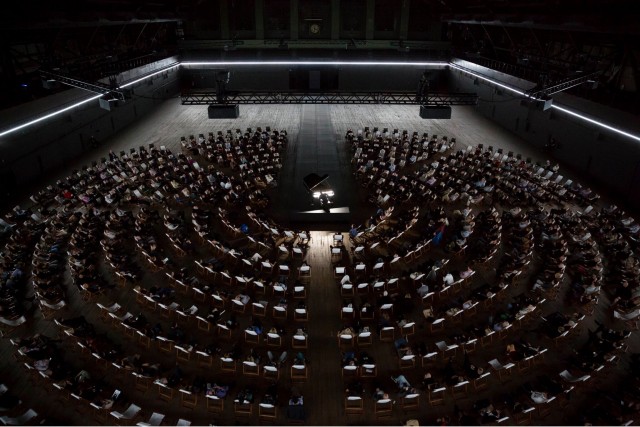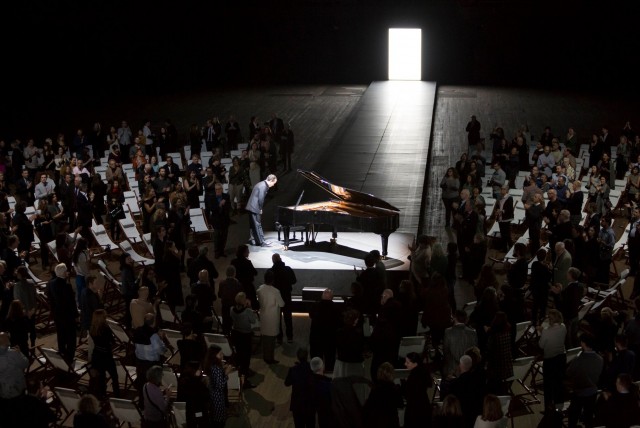
Marina Abramović, Urs Schönebaum, and Igor Levit collaborate on a whole new way to experience live music (photo by James Ewing)
Park Ave. Armory, Wade Thompson Drill Hall
643 Park Ave. between 66th & 67th Sts.
December 7-19, $65
212-933-5812
armoryonpark.org
In many ways, Marina Abramović’s latest work, “Goldberg,” is a combination and the culmination of the ideas explored in her past half-decade of shows, this time focusing on the creation of a bold new way to experience live music. In 2010, the Serbian-born, New York–based performance artist spent 736½ hours in MoMA’s Donald B. and Catherine C. Marron Atrium sitting in a chair and locking eyes with individual museumgoers for extended periods of time as the highlight of her widely hailed participatory career retrospective “The Artist Is Present.” In December 2013, she examined her life and death in Robert Wilson’s visual spectacle The Life and Death of Marina Abramović at the Park Avenue Armory. And in last fall’s “Generator,” Abramović had visitors wear blindfolds and noise-canceling headphones as they moved across an empty space at Sean Kelly Gallery, occasionally making contact with others as well as the artist, who was often present, taking part in the show. For “Goldberg,” ticket holders arrive at the Park Avenue Armory and are asked to place all electronic devices (and coats and bags) in a locker, then are given a pair of noise-canceling headphones as they enter the fifty-five-thousand-square-foot Wade Thompson Drill Hall. At the center of the vast space are circular rows of white-cloth lounge chairs; people can sit anywhere, as it is general admission seating. The chairs are purposely set up a small distance away from one another to allow each person an individual, private experience. You are not meant to move your chairs together and chatter away (as the trio in front of me did) but instead relax, take in the atmosphere, and begin to focus on the performance at hand. Four screens have been set up on the four sides of the hall, blasting blazing white light, as if a visual white noise that is changing your perspective. Urs Schönebaum’s lighting design also includes a narrow band of light running around all four walls. At the far west end, pianist Igor Levit, who made his North American recital debut in March 2014 in the armory’s Board of Officers Room, sits at a Steinway grand piano. Soon a gong sounds, signaling everyone to put on their headphones. Over the course of the next fifteen minutes or so (exact time is not of the essence here), Levit and the piano slowly move to the center of the arrangement of chairs. Another gong sounds, the screens go blank, headphones are removed, and the Nizhny Novgorod–born pianist starts playing J. S. Bach’s Goldberg Variations as the piano makes one intensely slow revolution and he performs the gorgeous 1742 aria with thirty variations.
In a 2010 interview with the Wall Street Journal, Abramović said, “We always project into the future or reflect in the past, but we are so little in the present.” With “Goldberg,” she and Levit are practically forcing the audience to be present, to be in the moment. Removing nearly all distractions — without cell phones, watches, cameras, bags, or even a program (which are distributed on the way out) — Abramović and Schönebaum are making this experience all about the music, and what music it is, an absolutely dazzling performance by Levit, a rising star in the classical world. The twenty-eight-year-old plays the Goldberg Variations without sheet music, his hands making love to the keys, crossing each other and descending from above as he lifts his elbows with lovely flourishes. As he plays, his body sways in all directions, giving a physical quality to the music even as the three collaborators have conceived of this piece as a kind of celebration of immateriality. It’s also as if the concert is being performed just for you; when fully reclined in the chair, you cannot easily shift your body to look at the people next to you or, of course, behind you; instead, your head is positioned to face Levit only, and there is really no reason to look anywhere else. Aside from an occasional snore — the seats are rather cozy, and what would a classical concert be without at least some snoozing — the only thing to be heard is the glorious music, which has a palpable energy all its own. “To play this work, to love it and to listen to it is an experience second to none,” Levit says in the program. “Every aspect of human nature can be relived. At the end words cannot describe it. We shouldn’t discuss this work. We should and indeed can experience it. What a pleasure!” We can’t explain it any better than that. On opening night, Abramović was hanging out in the halls of the armory before the show, greeting friends and expressing her nervousness. At the end of the performance, Levit ran into the audience and gave Abramović a great big hug, filled with what appeared to be both relief and release. Thus, the artist was indeed present, and so was the audience. Now, if we can only apply Abramović’s method to film and theater…. (On December 13 at 5:00, Levit and Abramović will take part in a discussion moderated by outgoing armory artistic director Alex Poots. And you can listen to Levit’s performance of the Goldberg Variations at home on his latest album, Bach, Beethoven, Rzewski [Sony Classical, October 2015, $24.99], which also includes Beethoven’s Diabelli Variations and Frederic Rzewski’s “The People United Will Never Be Defeated!”)
